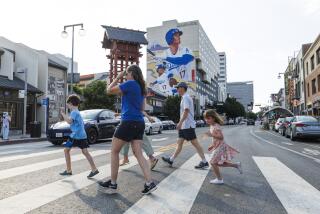Ferreting Out Areas Where Moles Thrive
- Share via
WASHINGTON — Beneath the political landscape of the nation’s capital lies an underworld replete with bugging devices, exchanges of top-secret files and counterintelligence agents intent on gaining the upper hand over their archenemies on the global stage.
At least that’s the scenario laid out for espionage fans who flock to SpyDrive, a bus tour of secret spying locations around Washington.
For more than two hours, tourists can glimpse settings for cloak-and-dagger intrigue from a bus that takes them around the city--from restaurants where U.S. spies once met with their Soviet counterparts to government agencies that were penetrated by espionage activity to the imposing Russian Embassy, described as a major nexus in battlefield Washington.
It’s not your typical Washington tourist fare, organizers acknowledge.
Spies in Your Own Yard
“We tend to associate espionage with the spy cities like Berlin and Vienna, but Washington, D.C., is as much a spy capital as any other city in the world,” said Peter Earnest, a retired CIA officer and guide, during a recent tour. “There is espionage going on in this city most likely as we sit here on this bus.”
The slightly breathless description on the organization’s Web site sets the tone: “Right this minute in Washington, D.C., someone is trying to recruit someone to be a spy. . . . Someone is leading a double life.”
The case of former FBI counterintelligence agent Robert Philip Hanssen, who recently agreed to plead guilty to charges that he spied for Moscow for more than 15 years, was a reminder that spying often happens close to home.
And the tour guides--former intelligence officers for the FBI, CIA, and KGB--all have firsthand experience with the subject.
“Unlike some tours where people are hired and they have to learn a script, these guys don’t have a script,” said Cindy Kwitchoff, spokeswoman for the Centre for Counterintelligence and Security Studies, the private group that operates the tour. “It comes from 30 or 40 years [of] experience.”
In addition to offering tours, the center provides training, analysis and consulting on counterintelligence to government and private agencies. Another Washington organization, the Cold War Museum, offers similar tours.
The SpyDrive tour, which costs $55, begins in front of the Washington Convention Center on 10th and H streets. After boarding the bus, passengers are given a glossary of spy terms like “dead drop” (a prearranged location for depositing and picking up messages and money) and “signal site” (a public place or object, like a mailbox, marked with tape or chalk to indicate that a task has been completed).
On a recent tour, the bus cruised past the FBI building on Pennsylvania Avenue and headed toward the Willard Hotel, a stone’s throw from the White House. Inside is a restaurant called the Occidental Grill, where Aleksandr Feklisov, a KGB officer, solicited information from U.S. contacts and Soviet sympathizers. In the 1940s, Feklisov recruited Julius Rosenberg, who was accused of selling nuclear secrets to the Soviets. Rosenberg and his wife, Ethel, were executed at Sing Sing Prison in New York in 1953.
As the bus passed the U.S. Treasury Department, Earnest pointed out that spies were planted in the agency by the Soviet KGB because of the potential wealth of useful information there and because of the rumor of an underground tunnel from the Treasury to the White House.
About seven blocks away on 16th Street is the old Soviet Embassy compound. The turn-of-the-century mansion now serves as home to the Russian ambassador and his family.
“The embassy itself was like a magnet for adventurers and mercenaries who wanted to earn an extra buck and who would come and offer their services,” said former KGB officer Oleg Kalugin, who led a recent tour with Earnest.
Kalugin said that when he worked at the embassy, agents and spies were able to move freely to and from the building without attracting attention by blending in with the crowds from the nearby office buildings, stores and museums.
Even the posh neighborhoods of bustling Georgetown aren’t immune from espionage.
Aldrich H. Ames, a high-ranking CIA officer considered one of the most notorious double agents in U.S. history, sold the names of more than 10 CIA agents and FBI sources to the KGB at Chadwick’s restaurant in Georgetown, near the Washington Harbor, Earnest said. The agents were eventually executed and Ames was sentenced to life in prison in 1994. An Irish pub in Georgetown, St. Martin’s Tavern, was also used to cultivate U.S. officials and agents in the advanced stages of recruitment.
Dumbarton Oaks, a lush 19th century estate that houses a collection of Byzantine and pre-Columbian art, was where Jonathan Pollard, a civilian Navy intelligence analyst who spied for Israel, exchanged information with Col. Aviem Sella, an Israeli intelligence officer.
The tour ends near Washington’s Taft Bridge, the location of one of Hanssen’s alleged dead drop sites with the Russians, Earnest said.
Street Smarts
Marcie Peck, a communication specialist from Washington, said she bought her husband, Jeff, a seat on a recent tour for his 34th birthday. An ardent spy buff, Peck said he learned facts on the short trip that he never knew from reading Tom Clancy novels.
“We’ve been living here for quite a long time and we saw all the monuments, but this is obviously a unique perspective on what goes on in the life of this city,” Peck said. “You can see a lot of movies, but getting firsthand accounts on what really happened in the spy world is fantastic.”
More to Read
Sign up for The Wild
We’ll help you find the best places to hike, bike and run, as well as the perfect silent spots for meditation and yoga.
You may occasionally receive promotional content from the Los Angeles Times.






